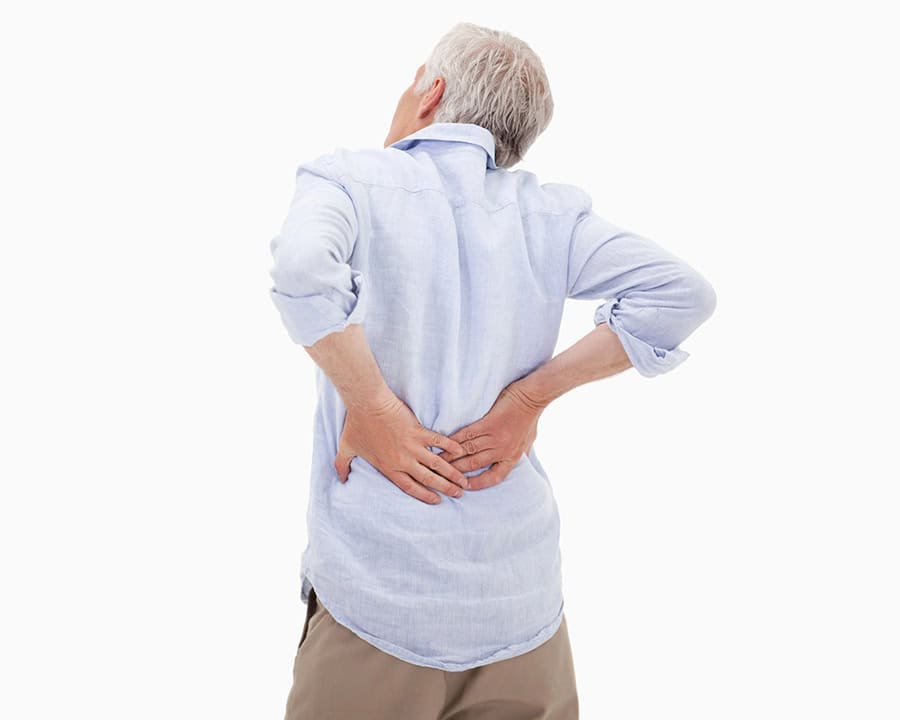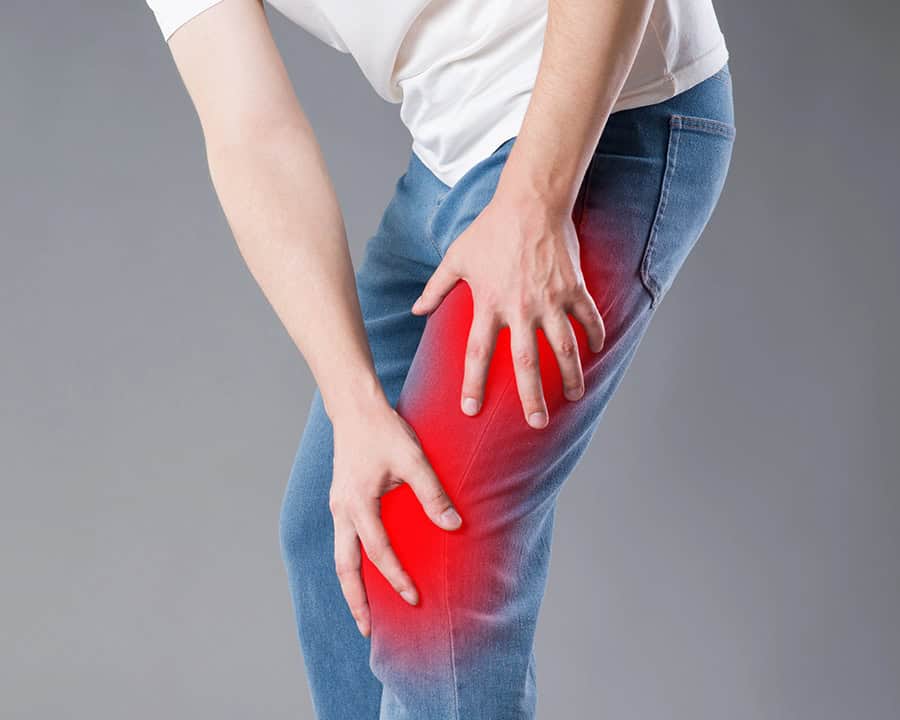Our bodies undergo various changes as we age, making them more and more susceptible to common back problems. For people over 60 back pain can significantly impact the quality of your life limiting mobility and daily activities. In this article, we will explore the common back problems faced by people over 60, how they occur, and strategies for prevention and management.
What factors influence common back problems?
Degenerative disc disease (DDD) is primarily caused by the natural aging process where the spinal discs lose water content, becoming less flexible and shock-absorbent. Additionally, repetitive stress from daily activities, sports injuries, or even genetics can contribute to the breakdown of disc tissue, leading to pain, stiffness, reduced mobility, and discomfort. The process can be accelerated by factors such as a family history, natural wear and tear on the discs and previous back injuries can also accelerate disc degeneration.
How can I prevent Degenerative Disc Disease?
You can prevent DDD by practicing good posture, reducing stress on the spine, and strengthening your core muscles for better support. Regular low-impact exercises like walking, swimming, and yoga will help the spine maintain flexibility and strength. It is also important to maintain a healthy weight.
 How can I manage DDD?
How can I manage DDD?
The management of degenerative disc disease often starts with conservative approaches like pain relievers and anti-inflammatory medications, physical therapy, and heat or cold therapy. For severe cases, epidural injections or surgery might be considered. Lifestyle modifications including ergonomic adjustments and stress management are crucial for long-term relief and help to alleviate symptoms.
What is Spinal Stenosis?
Spinal Stenosis is a natural degeneration of spinal structures and often occurs due to age-related wear and tear that leads to bone spurs and thickened ligaments. Other factors include herniated discs, spinal injuries, and congenital spinal abnormalities. Less frequently, tumors or bone diseases can contribute to spinal stenosis.
How Can I Prevent Spinal Stenosis?
Preventing spinal stenosis involves maintaining a good posture, regular exercise, and a healthy weight. To manage symptoms, consider physical therapy, pain medication, epidural steroid injections, or in severe cases, surgery to create more space in the spine.
How Can I Manage Spinal Stenosis?
Specific exercises and physical therapy such as stretching and strengthening exercises can help maintain spinal flexibility, reduce symptoms, and can help reduce pressure on the nerves. It is important to maintain a healthy weight, as this will reduce stress on the spine. In severe cases, surgical intervention may be necessary to relieve nerve compression.
What is Osteoarthritis and the Causes?
Osteoarthritis, often referred to as “wear and tear” arthritis, primarily results from the gradual breakdown of cartilage in joints. Age is a significant risk factor as cartilage naturally deteriorates over time. Obesity increases stress on weight-bearing joints, accelerating cartilage breakdown. Past injuries, repetitive joint use, and genetic predisposition also play roles. Additionally, bone deformities and underlying medical conditions can increase susceptibility to osteoarthritis. This condition can lead to pain, stiffness, and decreased range of motion.
How Can I Prevent Osteoarthritis?
While you can’t completely prevent osteoarthritis, adopting healthy habits can significantly reduce the risk. Maintaining a healthy weight is crucial as excess weight puts pressure on your joints. Regular exercise, especially low-impact activities like swimming or walking, helps strengthen muscles and protect joints.
Proper posture and body mechanics can also help. In addition, a balanced diet rich in antioxidants and omega-3 fatty acids supports joint tissue health. Remember, early detection and management are key to slowing the progression of osteoarthritis.
How Can I Manage Osteoarthritis?
Managing osteoarthritis involves a multifaceted approach. Regular low-impact exercise helps strengthen muscles supporting joints, and reducing strain. Maintaining a healthy weight alleviates pressure on affected areas. Heat and cold therapy can provide temporary relief from pain and stiffness.
Over-the-counter pain relievers or prescription medications may be necessary for symptom management. Devices such as canes or braces can aid mobility and reduce joint stress. Consulting with healthcare professionals for tailored advice and potentially physical therapy is essential for effective osteoarthritis management.
What is Osteoporosis and the Causes?
Osteoporosis is a condition characterized by weakened and brittle bones primarily caused by an imbalance between bone resorption, where old bone tissue is broken down, and bone formation where new bone tissue is created. This imbalance typically occurs with age as the body’s ability to rebuild bone diminishes leading to a gradual loss of bone density.
However, other factors such as hormonal changes, particularly in women after menopause, dietary deficiencies especially calcium and vitamin D, certain medications like corticosteroids, and underlying health conditions like hyperthyroidism or rheumatoid arthritis can accelerate bone loss and increase the risk of osteoporosis.
How Can I Prevent Osteoporosis?
Preventing osteoporosis involves a multifaceted approach. A diet rich in calcium and vitamin D is crucial and found in dairy products, leafy greens, and fatty fish. Regular weight-bearing exercises like walking, dancing, or lifting weights stimulate bone growth. Maintaining a healthy weight is essential.
Avoiding smoking and excessive alcohol consumption is vital, as both can hinder bone health. Regular check-ups and bone density scans can help monitor bone health and detect early signs of osteoporosis.
How Can I Manage Osteoporosis?
Managing osteoporosis often involves a combination of strategies. Medications can slow bone loss and increase bone density. Weight-bearing exercises help strengthen bones and reduce fracture risk. A diet rich in calcium and vitamin D and supplements if needed supports bone health. Fall prevention measures are also crucial. Regular check-ups and bone density scans help monitor progress and adjust treatment accordingly.
 What is Sciatica and the Causes?
What is Sciatica and the Causes?
Sciatica refers to pain that radiates along the sciatic nerve, which extends from the lower back down the legs. It is often caused by compression of the nerve roots in the lower spine.
How can I prevent Sciatica?
Preventing sciatica involves maintaining a healthy lifestyle and proper body mechanics. Regular exercise particularly core and back strengthening helps stabilize the spine. Good posture while sitting, standing, and lifting is crucial to avoid undue pressure on the sciatic nerve.
Maintaining a healthy weight and practicing proper lifting techniques such as bending your knees and keeping your back straight can significantly lower the risk of sciatica. Consistent movement and avoiding prolonged sitting or standing are also beneficial.
How Can I Manage Sciatica?
Managing sciatica often involves a combination of self-care and potential medical interventions. Over-the-counter pain relievers along with gentle exercises and stretches can provide relief. Applying ice or heat to the affected area depending on the severity of pain can help reduce discomfort.
Maintaining good posture and ergonomics is crucial. For persistent or severe symptoms consulting a healthcare professional may be necessary to explore options like physical therapy, corticosteroid injections, or in rare cases surgery.
Conclusion
Back problems are common among people over 60 due to the natural aging process and associated conditions such as degenerative disc disease, spinal stenosis, osteoarthritis, osteoporosis, and sciatica.
However, proper prevention and management strategies minimize the impact of these conditions and maintain a good quality of life. Regular exercise, a healthy diet, good posture, weight management, and regular medical check-ups are essential for maintaining back health in older adults. By taking proactive steps, you can enjoy a more active and pain-free life even as you age.
Liked this post? Here are some additional posts by Bellefleur Physiotherapy.
Kinesiology Tape: 3 reasons why it’s beneficial and an advantage in the recovery process
Headaches, jaw pain and teeth grinding: are these problems all related to the TMJ?







